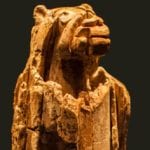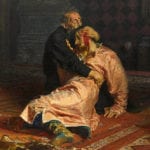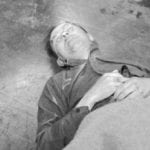 Movies and TV
Movies and TV  Movies and TV
Movies and TV  History
History 10 Things You Didn’t Know About the American National Anthem
 Technology
Technology Top 10 Everyday Tech Buzzwords That Hide a Darker Past
 Humans
Humans 10 Everyday Human Behaviors That Are Actually Survival Instincts
 Animals
Animals 10 Animals That Humiliated and Harmed Historical Leaders
 History
History 10 Most Influential Protests in Modern History
 Creepy
Creepy 10 More Representations of Death from Myth, Legend, and Folktale
 Technology
Technology 10 Scientific Breakthroughs of 2025 That’ll Change Everything
 Our World
Our World 10 Ways Icelandic Culture Makes Other Countries Look Boring
 Misconceptions
Misconceptions 10 Common Misconceptions About the Victorian Era
 Movies and TV
Movies and TV The 10 Coolest Stars to Set Sail on The Love Boat
 History
History 10 Things You Didn’t Know About the American National Anthem
 Technology
Technology Top 10 Everyday Tech Buzzwords That Hide a Darker Past
Who's Behind Listverse?

Jamie Frater
Head Editor
Jamie founded Listverse due to an insatiable desire to share fascinating, obscure, and bizarre facts. He has been a guest speaker on numerous national radio and television stations and is a five time published author.
More About Us Humans
Humans 10 Everyday Human Behaviors That Are Actually Survival Instincts
 Animals
Animals 10 Animals That Humiliated and Harmed Historical Leaders
 History
History 10 Most Influential Protests in Modern History
 Creepy
Creepy 10 More Representations of Death from Myth, Legend, and Folktale
 Technology
Technology 10 Scientific Breakthroughs of 2025 That’ll Change Everything
 Our World
Our World 10 Ways Icelandic Culture Makes Other Countries Look Boring
 Misconceptions
Misconceptions 10 Common Misconceptions About the Victorian Era
10 Works Of Art The Nazis Deemed ‘Degenerate’
Hitler’s takeover of Germany and its surrounding nations was not merely a military or genocidal feat. He wanted to completely overhaul the cultural fabric of Germania. That also applied to paintings. There was a certain style of German art that he believed was superior, such as the work of the “Old Masters” or realistic paintings of wholesome events.
In particular, Hitler wanted to eradicate modern art. According to the Reich, modern art was depraved and irrational. Dadaism, Impressionism, Cubism, Expressionism, and Surrealism were all verboten, and these paintings were all hauled out of museums. Hitler even declared, “The Dadaists, Cubists, and those futuristic expressive ones and those objective chatterers will under no circumstances participate in our cultural renaissance.”
In July 1937, over 650 works were exhibited in the Institute of Archaeology in the Hofgarten in Munich. The pieces were displayed under the title of Entartete Kunst (“Degenerate Art”). Painted on the wall were captions, including ones that read, “Insolent mockery of the Divine under Centrist rule,” “An insult to German womanhood,” and “Revelation of the Jewish racial soul.”
On March 20, 1939, around 5,000 paintings, drawing, and sculptures were thrown into a bonfire under the supervision of the Berlin Fire Department. More were destroyed in Paris in July 1942.
Thankfully, many museum curators and ordinary citizens saw the Reich’s savagery for what it was. Many works were smuggled out of occupied countries or hidden in desolate farmhouses or caves. Here are the stories of 10 works of art condemned by the Nazis and the people who created them.
10 Moon Over A Mountain Lake
Max Beckmann
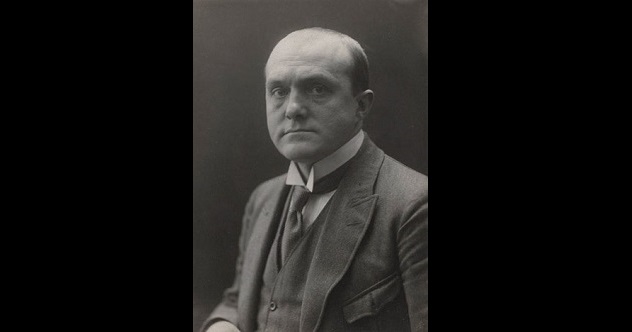
Max Beckmann (pictured above) focused on exaggerated, distorted, figurative drawings, which places him among the Expressionist artists. After his traumatic experiences serving in World War I, he sought to explore spiritual and political themes in his art. Beckmann’s work was well received in postwar Germany, and he even received awards for his paintings.
However, after Hitler’s rise to power, Beckmann was dismissed from his teaching position at the Stadel Art School in Frankfurt. More than 500 of his works were removed from museums that same year. Beckmann fled to Amsterdam, where he waited out the war before immigrating to the United States.
Some of Beckmann’s pieces were featured in the 1937 Degenerate Art exhibit. In 2012, several of his important pieces were discovered in an apartment owned by an art collector who’d gotten his hands on hundreds of works looted by the Nazis. The watercolor Moon Over a Mountain Lake does not appear to have been one of those paintings, but it was seized from the National Gallery in Berlin during the war, and it’s now exhibited at the Bavarian State Painting Collections in Munich.
9 Bathers With A Turtle
Henri Matisse
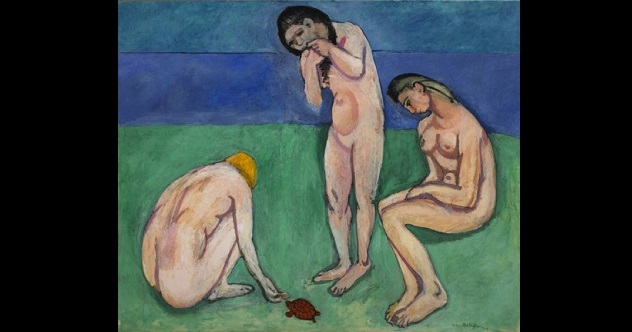
Henri Matisse pioneered the style of Fauvism, a style of broad, visible brushstrokes and strong, unrealistic colors that clashed with Hitler’s vision of proper artwork. As such, Matisse’s works were at serious risk.
The Nazis were a practical regime. They didn’t just destroy artwork they disliked. They would often sell it cheaply to raise foreign currency for the Reich. In 1939, Joseph Pulitzer Jr. was on his honeymoon when he came across one of these auctions taking place in Lucerne, Switzerland. After consulting with Pierre Matisse, son of Henri, he managed to rescue the painting for just $2,400. Pulitzer described the artwork for sale as “the most creative works of then-existing artists of that period.”
Matisse was permitted to continue exhibiting his works in Paris, assuming he signed an oath declaring his “Aryan” status. He did so, writing to his son that he felt he would be “deserting” his homeland if he fled.
8 The Absinthe Drinker
Pablo Picasso
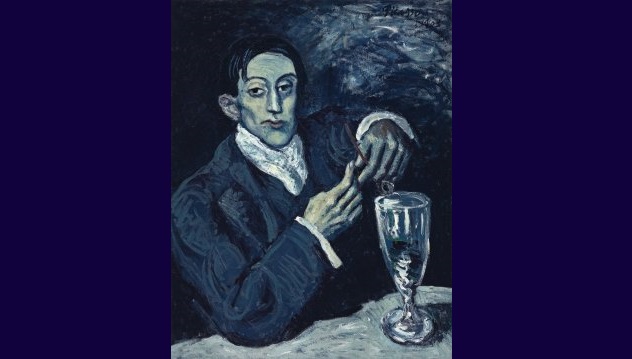
The Abstraction and Cubism of Pablo Picasso’s paintings clearly made him a target for Nazi ridicule. While Picasso remained in Paris during the German occupation, he did not exhibit his work during this time. His famous Guernica showed his hatred of both warfare and the Third Reich, and the Nazis were surely aware.
However, The Absinthe Drinker was produced before the rise of the Nazis, during Picasso’s “Blue Period.” Also known as Portrait of Angel Fernandez de Soto, it depicts the young artist drinking a glass of absinthe in front of a dark background. The painting became controversial in 2006 when then-owner Andrew Lloyd Webber announced his intentions to auction the painting for charity. Descendants of the previous owner, Paul von Mendelssohn-Bartholdy, protested that the painting had originally been sold under duress from the Nazis.
Indeed, the Mendelssohns (descendants of famed composer Felix Mendelssohn) have been trying to reclaim a number of paintings, including works by Picasso and van Gogh. When Mendelssohn-Bartholdy, a German Jew with an Aryan wife, realized the Nazis would attempt to confiscate all Jewish property, he attempted to arrange his will so his wife would “pre-inherit” his incredible collection. His daughters would then receive the works after his wife’s passing. After his death, however, his widow sold a number of priceless paintings, though whether the auction was forced by the Nazis or not seems to be a subject of debate.
Eventually, the matter was settled out of court, with Lloyd Webber retaining ownership. The painting was sold to an anonymous bidder in 2010.
7 Reclining Nude
Gustav Klimt
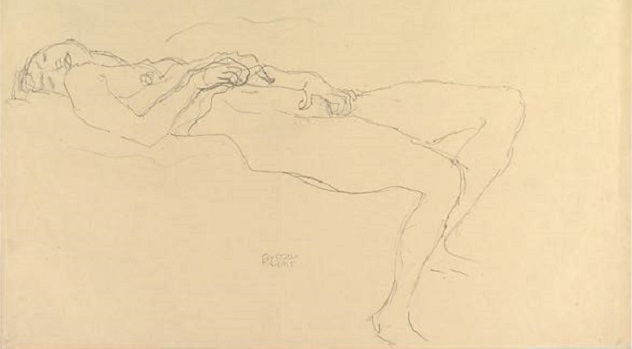
The abstract and erotic focus of Gustav Klimt’s work made him anathema to the Nazis, even though Klimt had died in 1918. Two of his drawings, both female nudes seized from the Kunsthalle Mannheim museum, are included in Freie Universitat Berlin’s database. Sadly, their current locations remain unknown, lost to the annals of time.
The particular tragedy of Klimt’s work focuses around a woman named Adele Bloch-Bauer. Adele and her husband, Ferdinand, were members of Vienna’s high society. Adele posed for two of Klimt’s portraits and possibly more paintings, including his most famous work, The Kiss. When Adele died at 43 years old, her husband created a memorial in their home using Klimt’s artwork. However, when the war began, the Jewish Bloch-Bauer was forced to flee his home and abandon all his property. He died in exile in 1945.
However, his niece, Maria Altman, gained some justice for her late aunt and uncle. In 2006, an Austrian arbitration board ordered that five paintings, including the two portraits of Adele, be returned to Maria Altman’s possession. The paintings are estimated to be worth $150 million. One now hangs in the Neue Galerie in New York and the other in the Museum of Modern Art.
6 Self-Portrait Dedicated To Paul Gaugin
Vincent Van Gogh
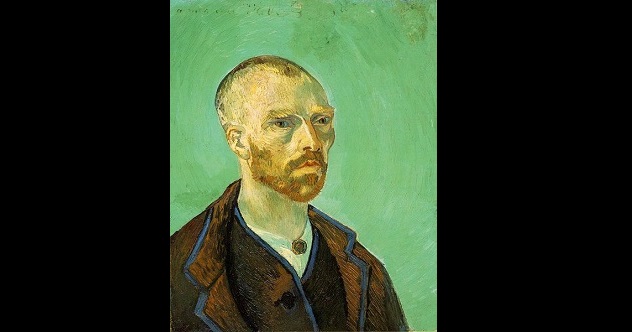
Vincent van Gogh’s work found itself under Nazi scrutiny due to his Expressionist influences. The distorted swirls and cascading colors were too modern, thus making them too degenerate.
Van Gogh’s self-portrait on a stunning seafoam background was donated to the Neue Staatsgalerie in Munich in 1919, but just 20 years later, it was targeted by the Nazis. At some point between 1937 and 1938, the portrait was taken from the walls of the museum and auctioned for funds at Lucerne.
The van Gogh was then purchased for a hefty sum by Maurice Wertheim, who bequeathed the painting to the Harvard Art Museums. Much like Joseph Pulitzer Jr., Wertheim “seemed to believe that to support what the Nazis detested was justifiable.” Unlike many other works on this list, the painting was taken from a state-run museum, and therefore, it is not legally required to be returned.
Ironically, the fact that it was seized may be why the painting survived. As World War II escalated, the Neue Staatsgalerie closed. To protect its paintings, some were shipped outside Munich. Others were housed in the museum basement. Sadly, the structure was bombed, and many works were destroyed. But thankfully, this van Gogh was saved.
5 The War Cripples
Otto Dix
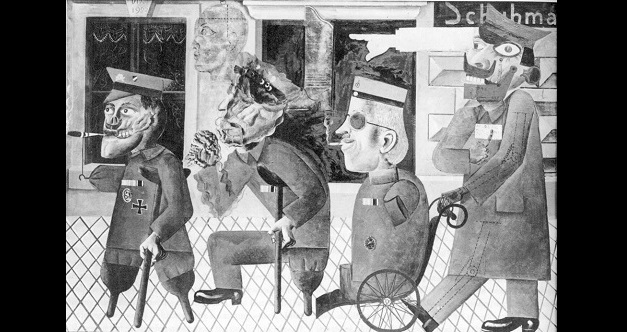
Of all the art styles that Hitler hated, he might’ve hated Dadaism the most. He railed against the style in Mein Kampf, claiming that Dadaism was “the degenerate excess of insane and depraved humans.” Furthermore, he stated that Dadaists were “holding the expressions of national sentiment up to scorn, overturning the concepts of the sublime and the beautiful, the worthy and the good, finally dragging the people to the level of [their] own low mentality.”
The Dadaists would likely have been flattered by this depiction. Early Dadaism began as sort of an “anti-art” movement, a satirical attack on capitalism and the bourgeoisie that many Dadaists believed had drawn their nations into World War I. According to artist Hans Richter:
“For everything that art stood for, Dada was to represent the opposite. Where art was concerned with traditional aesthetics, Dada ignored aesthetics. If art was to appeal to sensibilities, Dada was intended to offend.”
It’s no wonder, then, that Otto Dix’s hard-hitting The War Cripples remains lost. Though it is a painting, the style almost seems like a collage made from magazines. The painting ridicules everyone, including the military for crippling poor men, the public for their strange fascination with the handicapped, and the injured men themselves for retaining pride in a country that sent them to war. The painting was featured in the Degenerate Art exhibit, and then it was probably destroyed.
4 Color Order
Hans Richter
Hans Richter was another Dadaist who unabashedly opposed the Nazis. Richter, who’d served in World War I and had become partially paralyzed, firmly believed it was the duty of artists to oppose war and support revolution. He slammed militaristic Germany in his pen-and-ink drawings and studied color and composition in his abstract paintings. Richter was also a pioneer in abstract film, with his Rhythmus 21 being extremely important in the movement.
Obviously, neither his heavy satire nor excessive use of abstract lines and color could remain in the Reich’s cultural vision.
Farbenordnung, which translates into Color Order, appears to be one of Richter’s abstract color studies. Once housed in the Provincial Museum in Hannover, it was seized and exhibited in Entartete Kunst before it was finally destroyed. As for Richter himself, he immigrated to the US in 1941.
3 Winter Garden
Paul Klee, 1925
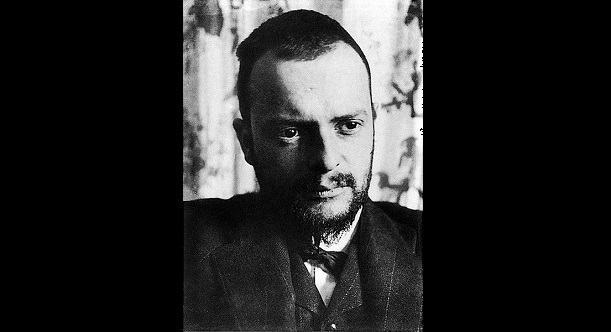
Paul Klee has the unsavory distinction of being a rare Jewish artist in the time of the Nazis. In addition to this “terrible crime,” Klee was a modern artist. Though difficult to classify, his painting spanned the realms of Expressionism, Cubism, Surrealism, and Abstraction.
From 1931 to 1933, Klee taught at the Dusseldorf Academy. However, his career was cut short by an investigative Nazi newspaper. “He tells everyone he’s a thoroughbred Arab,” reported the rag,” but he’s a typical Galician Jew.” The Gestapo searched his home, and Klee was fired.
To deal with this event, Klee created Struck from the List, a painting in which a monochromatic, abstract person is seen crying as a black “X” covers his (or her) face. Klee and his family fled to Switzerland shortly thereafter. As for his work entitled Winter Garden, it was seized from the Civic Museum of Arts and Crafts in Halle, along with hundreds of his other works. Tragically, 17 of his paintings were exhibited in Entartete Kunst, and this particular piece was destroyed.
2 La Belle Jardiniere
Max Ernst
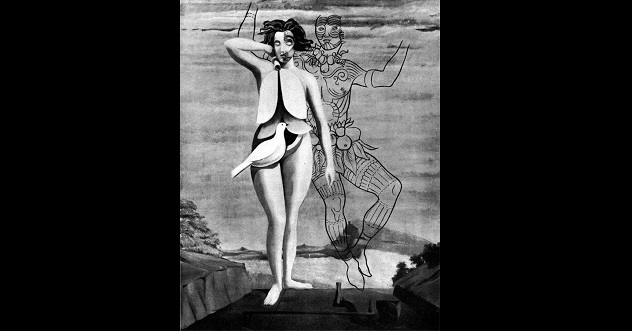
Max Ernst was yet another Dadaist, and when World War II broke out, Ernst found himself trapped in Paris as an “undesirable foreigner,” even though he was a native German. After the intercession of some famous friends, Ernst was released, only to be later arrested by the Gestapo when the Germans invaded Paris. He then managed to escape to America with the help of Peggy Guggenheim, a wealthy patron of the arts.
Ernst was unafraid of tackling touchy subjects in his artwork. In one famous painting, Ernst depicts the Virgin Mary spanking a young Christ while three famous painters, including Ernst, watch from a window. In La Belle Jardiniere (Creation of Eve), Ernst paints a nude Eve, complete with a scandalously placed dove. Behind Eve, there’s a line drawing of a woman made of fruit.
At least two of Ernst’s works were displayed in Entartete Kunst. Interestingly, a photo taken at the exhibit shows Hitler walking past La Belle Jardiniere. Sadly, records of this painting were lost after the event, and it may have been destroyed by the Nazis.
1 Self-Portrait As A Soldier
Ernst Ludwig Kirchner, 1915
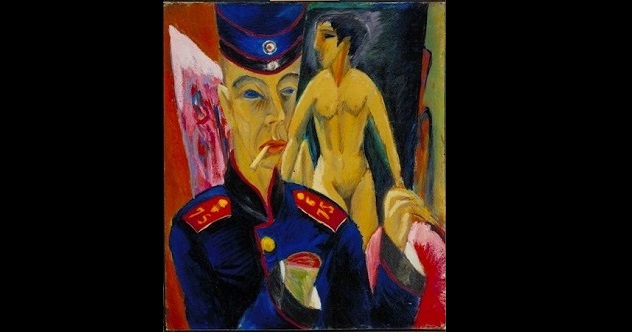
Ernst Ludwig Kirchner led a troubled yet influential life. He was plagued by physical and mental illnesses, both made worse by his time as a World War I soldier. However, he was also the founding member of “The Bridge,” a group that hoped to form, well, a bridge between old and new styles of art. Thanks to Kirchner, these artists were highly influential in the period leading to the advent of Expressionism.
Self-Portrait as a Soldier is probably one of the most important pieces Kirchner ever created. In the foreground, we see Kirchner in military uniform, holding up a stump where his right hand once was. His face is highly stylized. In the background, we see the artist’s studio, complete with a nude model. The colors are bright, yet they’re sad as well. It brings together the complexities that Kirchner was dealing with during this time in his life.
In 1933, the Nazis rose to power, damning Kirchner’s abstract style and making it impossible for him to sell his paintings. He was forced to resign from the Prussian Academy of the Arts. In 1937, over 600 of his works were removed from museums in Germany, and at least 32 were displayed at the Degenerate Arts exhibit. Tragically, Kirchner took his own life in 1938.
Hannah is a freelance writer and skydiver. A proud Jersey girl with a background in political science, criminal justice, and car sales, she can be reached here for commissions and other information. You can read more of her work at morbidstreak.blogspot.com.
